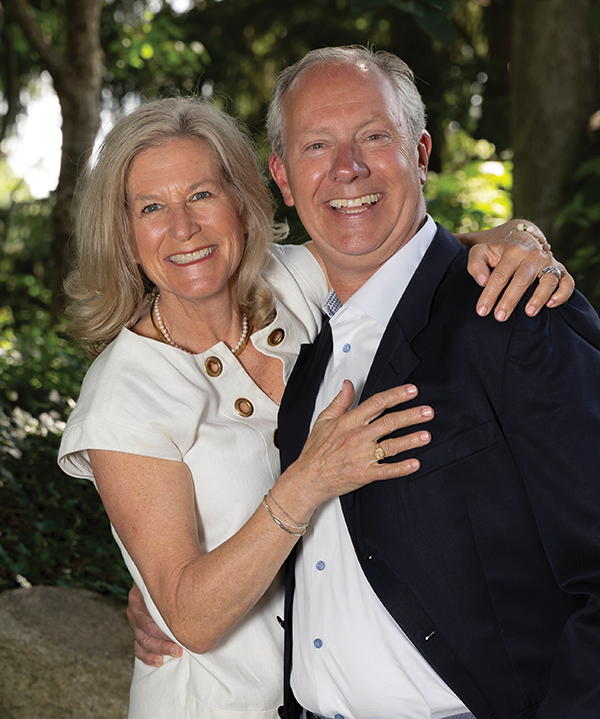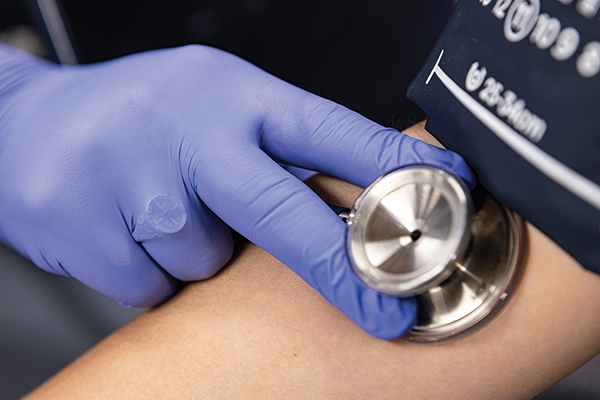Nursing Programs Secure Enduring Support

Since Saint Mary’s was founded over 180 years ago by the Congregation of the Holy Cross, Nursing Science has become one of the College’s most sought-after educational programs. A quiet walk through Our Lady of Peace Cemetery illuminates the rich history of the program through the American flags dotting the graves of the sisters who served as nurses during the American Civil War. Just a few steps to the east is the Center for Integrated Healthcare Education (CIHE) in Regina Hall, a state-of-the-art healthcare training facility representing the empowered future of healthcare and behavioral sciences at the College.
Donors like Mary McEnery Harding ’84 and her husband Dr. Alphonse Harding (ND ’84), who recently established the Harding Nursing Leadership Fund, want to ensure the program’s continued vitality in the teaching and the training of the students well into the future. This endowed fund will expand experiential learning in nursing—including student-faculty research, travel support, and a continued investment in technologies—so students have access to training on the latest healthcare equipment in the ever-changing healthcare landscape.
“Saint Mary’s is critical to the growth and betterment of the South Bend community, and by supporting the Ring Out Ring True campaign, we can be better citizens of South Bend,” Mary said during a recent interview. Currently in its “quiet phase,” the College’s Ring Out Ring True comprehensive campaign will enhance academic programs across Saint Mary’s. The Hardings are inveterate ambassadors and supporters of both Saint Mary’s College and the University of Notre Dame, so it was natural that Mary be part of the campaign’s Executive Committee. The Hardings were also co-chairs of the campaign to build Saint Joseph High School in South Bend. Additionally, Mary has served in volunteer leadership positions with the Center for the Homeless, the Junior League, the St. Vincent De Paul Society, and Christ the King Catholic School.
A legacy family at both Saint Mary’s College and the University of Notre Dame, several members have dedicated their lives to the healthcare field. Al is a Radiologist; daughter Clare Harding ’21 is a nurse at Northwestern University Hospital, Chicago; and niece Nora Napleton ’19 is a nurse at the University of Chicago Hospital. Other family members graduating from Saint Mary’s include Mary’s mother Sistie Doherty McEnery ’58, sister Clare McEnery Napleton ’87, and her late aunt Mimi Doherty ’56.
“My mom went to Saint Mary’s and so did her sister. I honored them and wanted to be a great student like them,” Mary said. “I too had high academic aspirations and knew Saint Mary’s was rigorous. It could be a launching board for me to go anywhere.” She added, “Saint Mary’s is filled with history and tradition of excellence. The best thing about it was the opportunity to meet lifelong friends who are today my friends and almost like sisters.”
A Rich History

The rich history of the Saint Mary’s nursing program started in 1861 when Mother M. Angela Gillespie and six Sisters of the Holy Cross began tending—without formal training—to wounded Civil War soldiers, first in Cairo, Illinois, then moving to Paducah, Kentucky. By the time the war ended, 40% of the 160 sisters living in the US had served as nurses, earning $2 per day and later a pension, which they used to help fund the building of Bertrand Hall. In 1907, the sisters opened Saint Joseph Hospital School of Nursing in South Bend.
In 1935, Sister Maria Amadeo, CSC, officially launched a five-year baccalaureate nursing program at Saint Mary’s, the first in Indiana and one of the earliest in the country. Later, in 1949, Amadeo established the Holy Cross Central School of Nursing, a three-year diploma and accreditation program that provided standardized nursing training at the five Congregation hospitals in Illinois and Indiana. Graduates of the program could add a fourth or fifth year at Saint Mary’s to secure a Bachelor of Science in Nursing. By 1962, however, the final students of the baccalaureate nursing program graduated, and the program was closed due to a lack of funds needed to support the program’s faculty, teaching equipment, and opportunities for clinical experiences.
Eleven years later, the program was reestablished in 1973—becoming accredited by both the Indiana State Board of Nursing and the National League for Nursing Accreditation Commission—and has continued to grow and evolve. By 2011, alumna Marjorie A. Neuhoff ’61 had established an endowed professorship in nursing through her estate which would provide the program with even more vitality, prestige, and prominence.
A Vibrant Present
In 2021, a $1 million grant from Lilly Endowment, Inc. transformed the center of Regina Hall into the Center for Integrated Healthcare Education. First opened to the Department of Nursing Science, CIHE will eventually house all of the College’s health and behavioral sciences: Speech-Language Pathology, Social Work and Gerontology, and Autism Studies.
Currently, Saint Mary’s offers a Bachelor of Science in Nursing, a direct-entry Master of Science in Nursing, and a Doctor of Nursing Practice. Through a partnership with Guidestar Eldercare, the College also offers a Geriatric Neuropsychiatry certificate for advanced practice nurses, the only one of its kind in the nation. And, during the summer, a residential Healthcare Summer Institute is offered for high school students interested in a career in healthcare.
According to BSN program director Cibele Webb PhD, RN, a world-class center like CIHE, with its high-tech patient simulation mannequins, allows students to develop essential competencies in a supportive, student-centered environment. “Our facilities have evolved over the years, and we are known for offering the most up-to-date equipment and innovative teaching strategies that prepare nurses for modern healthcare,” Webb said. In the simulation labs, BSN students develop clinical excellence through practicing skills such as IV placement, wound care, catheterization, injections, CPR, and medication administration, while also cultivating patient-centered communication skills and evidence-based clinical reasoning.
Webb explained that the high-fidelity mannequins mimic real patient responses by breathing, responding to treatments, and showing signs of improvement or decline based on the care provided by the student. “This allows students to practice clinical skills in a realistic, low-risk setting that builds both confidence and clinical judgment,” she said. Webb also highlighted that Saint Mary’s faculty bring current clinical experience into the classroom and continually update the curriculum. “We prepare nurses to be both competent and compassionate, ready to deliver excellent care across healthcare settings,” she said.
We prepare nurses to be both competent and compassionate.”
- -Cibele Webb Phd, RN,
BSN Program Director
Mary and Al believe that the Saint Mary’s nurse has an extra quality, which they attribute to the faith-filled, liberal arts curriculum along with the rigorous classroom and clinical work. “What Saint Mary’s is trying to do to educate young women is to capture the human characteristics too,” Al said. “To be skilled and knowledgeable and professional, but tender and compassionate and empathetic; to be filled with faith and to use that to be able to buoy other people up when they’re struggling.”
“Saint Mary’s College prepared my niece and my daughter to be excellent nurses not only because of the strong academics and rigorous coursework, but also because of the compassion and the learning intertwined with other opportunities on campus to practice their faith,” Mary added. Al agrees: “That foundational experience at Saint Mary’s College allowed both Nora and Clare to have the confidence to jump into really challenging nursing roles as intensive care nurses. Being strong in their faith and being strong in their words, and being strong in the knowledge that they are giving across to the patient’s families has been important, because sometimes the answers aren’t easy to give, or what the patients or their families want to hear.”
This quality in programming has earned Saint Mary’s College a reputation for training today’s students well, ranking 4th in the State of Indiana and 57th nationwide in Nursing Science programs, according to the 2024 Nursing Schools Almanac. Additionally, all programs in the Department of Nursing Sciences achieved a 100% first-time board licensure pass rate in 2024.
Several years ago at a white coat ceremony in which Saint Mary’s nursing students transitioning from theory to practice as they began their clinical rotations to take place in CIHE, assistant professor of Nursing Rick Becker recalled the brave Holy Cross sisters from the Civil War, whose final resting places he can see from his office window. “Remember your very first clinical day—your very first day of actual patient care? How did that day start?” he asked. “Among other things, you donned your Saint Mary’s scrubs—your nursing student uniform—in a way, your nursing student ‘habit’. You put it on, despite having little or no actual experience of what it represents, yet you still put it on in confidence that you’d grow into what it represents—just like those Holy Cross postulants who took up their habits when joining the order. You, like them, stepped out in faith and fortitude, and, sure enough, with God’s help and guidance from my colleagues and me, you are what your scrubs signify,” Becker said.
An Empowered Future
The future of healthcare will be a vastly different landscape from what the Holy Cross nurses of the Civil War era—and even students of today—could imagine. Technology changes rapidly, as will the scope and duties of the nurse of the future. With the generous support of the Harding Nursing Leadership Fund, the Saint Mary’s-educated nurse will be well-positioned to take on an ever-changing future through experiential learning, travel opportunities, and modern clinical facilities.
“There’s so much we don’t know yet, like how artificial intelligence is going to impact the world, impact professional training, impact how nurses will work in a hospital,” Al said. “Saint Mary’s will need to continuously incorporate state-of-the-art technology with nurses in their training, so that when they get to a hospital floor, or they get to an operating room, or to a doctor’s office, they know how to utilize those technologies and those techniques to be the best nurse that they can be.”
“The health and vitality of the Saint Mary’s nursing program is essential. What the Harding Nursing Leadership Fund can help with is the integrated and interdisciplinary teaching approach to health sciences,” Mary agrees. “We’re at a critical point in time in this world where we need better and well-trained nursing and health professionals, and by providing the funds from the Harding Nursing Leadership Fund, it will allow the students to go forward and do what they’ve always dreamed of doing: being a nurse.” ‖

